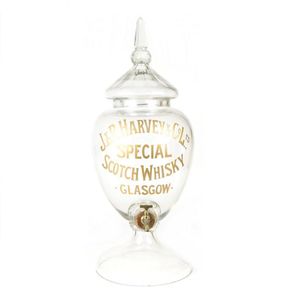Edwardian Whisky Dispenser with Glasgow Details
You must be a subscriber, and be logged in to view price and dealer details.
Subscribe Now to view actual auction price for this item
When you subscribe, you have the option of setting the currency in which to display prices to $Au, $US, $NZ or Stg.
- Finial - An architectural decoration, found on the upper parts of of an object. On furniture they are usually found on pediments, canopies and shelf supports. On smaller ceramic or silver items, such as spoons, they may decorate the top of the item itself, or the lid or cover where they provide a useful handle for removal.
Finials have a variety of shapes and forms. They may be urn-shaped, baluster shaped round or spiral, but usually taper into an upper point. Many real life shapes may also be used as finials, such as pineapples, berries, pinecones, buds, lotus and acorns. Sometimes animals such as a lion are depicted, or fish and dolphins. - Faceting - Faceting is a technique of removing material from a curved surface, to give a series of flat surfaces but retaining the profile of the original surface.
The technique is most commonly associated with diamond cutting where the various cuts used such as rose cut and brilliant cut, add life and sparkle to the stone, whilst at the same time removing as little of the stone as possible.
Faceting by grinding is also used to decorate glass. The stems of many drinking glasses are decorated by cutting a series of flat surfaces on a circular stem, and hollow vessels such as vases may have faceted surfaces.
In furniture faceting is often applied to legs of tables and chairs, where a circular baluster shaped section is flattened so as to form an octagonal section. - Edwardian - The Edwardian period of English furniture and decorative arts design is named for Edward VII (1841 ? 1910) who was King of the United Kingdom and the British Dominions and Emperor of India for the brief period from 1901 until his death in 1910. It follows the Victorian period, in turn was followed by the Art Nouveau and Art Deco styles. In Australia, designs of this period are also known as being in the Federation style.
This item has been included into following indexes:
Visually similar items

A French bombe commode with grey marble top with flecks of white and red colours, serpentine shape with moulded edge, with two deep drawers, the fascia and sides of pale and darker figured timber inlaid with sprays of flowers, rococo style ormolu handles,

A 9ct. yellow gold and diamond gents ring, the flat square mount set with three round brilliant cut diamonds and a radiating sun design, tapered flat shank with bark pattern to shoulders, total diamond weight 0.30ct.

A pair of Sevres vases and covers, French, 19th century, with fine ormolu mounts, decorated with lovers to the front and country scenes to the reverse, 46 cm high

A rare Imperial Coronation plate, period of Nicholas I, Russian, 19th century, finely decorated with radiating leaf motifs on gold ground, Gokhran inventory mark to base, 24 cm diameter
